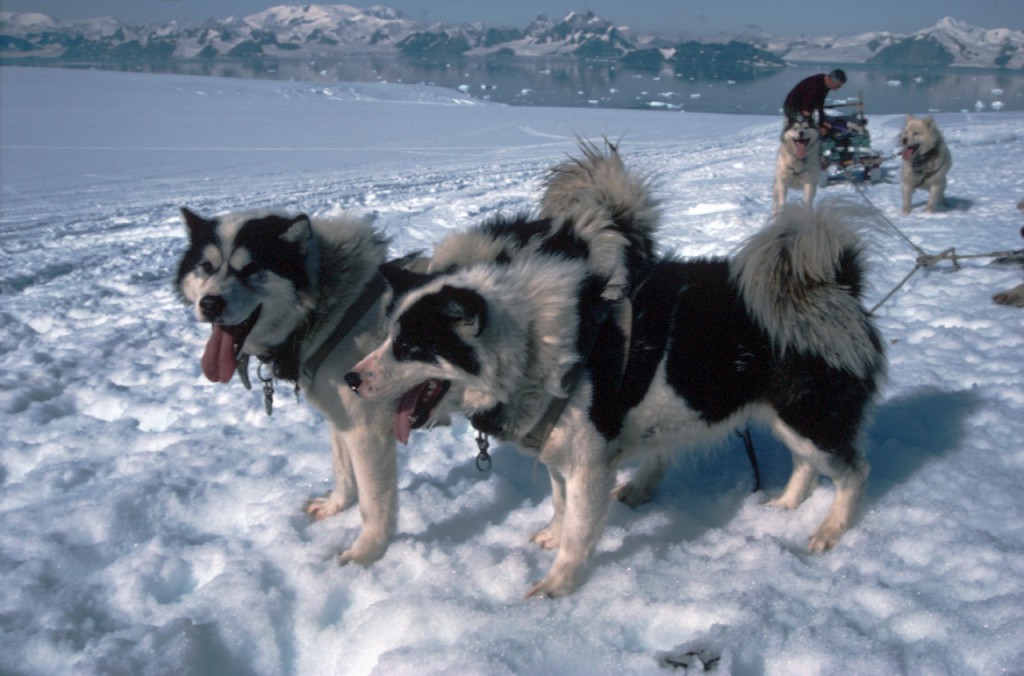Annex II to the Environmental Protocol (Conservation of Antarctic Fauna and Flora) required that dogs were removed from Antarctica by April 1994. This ban was introduced because of concern that dogs might introduce diseases such as canine distemper that might be transferred to seals, and that they could break free and disturb or attack the wildlife. It was also thought to be inconsistent for the Protocol to have strict controls on the introduction of non-native species, but at the same time allow huskies to be bred and used in Antarctica.
Dogs were taken to the Antarctic on the early ‘heroic age’ expeditions at the turn of the 20th Century. They were instrumental in helping the Norwegian explorer Amundsen and his team to be the first to reach the South Pole in 1911. The fact that the Norwegians were good and experienced dog handlers was thought by many experts to be one of the main reasons that they were able to reach the pole before Scott and his team. Since those days, dogs have been used extensively for polar travel and for the support of scientific work. Although dogs were slower than vehicles, they were considered to be safer as they were not so heavy and it was thought that huskies also had an awareness of crevasses.

Sledge dogs were used by BAS in the Antarctic from 1945. The original dogs were imported from the Arctic, from Labrador in Canada and there were small additions in stock from Greenland (1954 and 1961). Careful records were kept of the breeding to avoid producing dogs affected by hereditary disorders. Dogs were also exchanged between bases in Antarctica (eg. Argentinian base, San Martin) in order to maintain genetic diversity. At British stations, dogs were generally fed on seal meat and therefore a certain number of seals were killed each year to support them. The dogs were gradually replaced by mechanised transport during the 60s and 70s and skidoos became the main vehicle for transporting field parties overland.
In the 1980’s and early 1990’s, a small number of dogs were kept at Rothera Research Station for recreational purposes. The dogs were well looked after and gave station personnel the chance to get a feel for what the earlier explorers and scientists would have experienced. The dogs were also considered to be good for morale, which is important in an environment where people are away from home for periods of over two years. There was considerable resistance from station personnel when the legislation for the removal of the dogs was put in place.
The 14 remaining dogs were finally removed from Rothera in February 1994. To mark the end of the era, the dogs spent the last season doing what they did best, pulling a sledge as a working team in support of a surveying project on Alexander Island. When the dogs finally departed Rothera, special husky kennels were built and fitted inside the BAS Dash 7 aircraft for the 5-hour flight to the Falkland Islands. The dogs spent several weeks adapting to the warmer climate and new surroundings, experiencing grass, sheep and children for the first time. They flew from the Falklands to the UK on a special RAF Tristar flight. Once again the dogs received a warm welcome to the UK, this time becoming media stars in all the national papers. Once quarantine was completed the final leg of their journey took them to Quebec in Canada, courtesy of British Airways.
Of the 13 dogs who arrived in Canada, 5 died within the first year due to infection and disease. Unfortunately it was not possible to breed from any of the remaining dogs and the last two died in 2001. Sadly, the end of an era for the British Antarctic husky dogs.
For further information: “Of Dogs and Men: Fifty Years in the Antarctic” Edited by Kevin Walton and Rick Atkinson (1996). Images Publishing (Malvern) Ltd. (ISBN 1 89781755X).